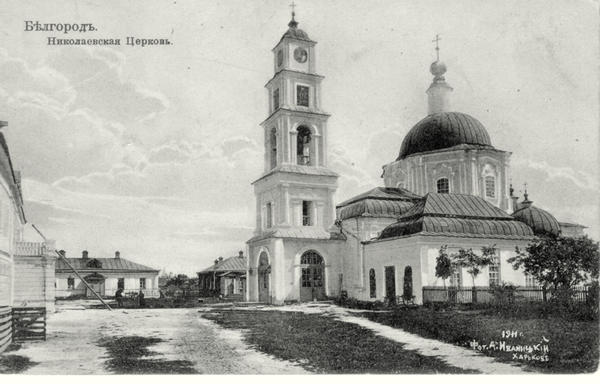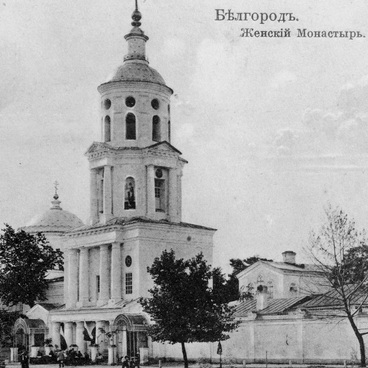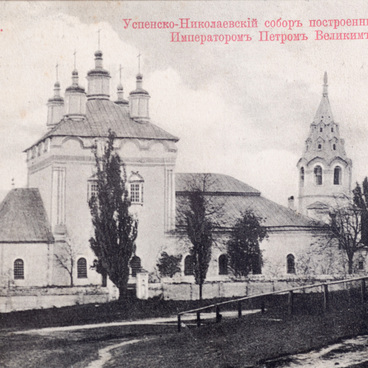The Saint Nicholas Monastery was erected shortly after the founding of Belgorod, in 1599. By decree of Boris Godunov, Prince Grigory Konstantinovich Volkonsky began the construction, which was completed under the governor Ambrose Ivanovich Ladyzhensky “according to a letter sent from His Holiness Patriarch Filaret Nikitich” (as per the “Description of the Kursk Governorate” by Sergey Ivanovich Larionov).
From the time of its foundation until the beginning of the 18th century, the monastery was supported by Boris Godunov, as well as tsars Mikhail Fedorovich, Alexei Mikhailovich and Pyotr Alekseevich, and other benefactors.
Hegumen Nicephorus was the first to head the monastery; Archimandrite Aaron, during his priorship (1715–1722), fought against the Cossacks of the Volchansky district, who caused “offenses and ruin” to the monastery. At the invitation of Bishop Joasaph (Gorlenko), in 1748–1751, Jacob Blonitsky, an associate of the Saint in matters of education, a translator of church books, the author of the Hellenic-Slovenian and Slovene-Latin lexicon, and the Grammar of the Church Slavonic language, worked within the frame of the monastery.
Despite the possession of numerous estates, the monastery as such gradually fell into decay. In the second half of the 18th century, an attempt was even made to relocate it to the Pyatnitskaya hermitage near Melovaya Gora. Archimandrite Gervasius (the prior in 1758–1764) advocated for this decision. With the blessing of Archbishop Peter (Smelich), a heated church, cells and the abbot’s chambers were arranged in a new place and the hermitage became to be known as Podmelogorsky Monastery (or the New Monastery). However, the idea was never fully implemented. In 1756, the Church of Saint Parasceve “Friday” was consecrated in the Saint Nicholas Monastery, and in 1762, the Saint Nicholas Church was inaugurated, for which the Borisovka-based icon painter Vlas Malyar painted a new iconostasis. Archimandrite Matthew ordered the buildings from the Podmelogorsk monastery to be returned to their original place. Having existed for 244 years, the monastery was closed under Nicholas I. Its last prior was hegumen Hierotheus.
Before the revolution of 1917, an artillery brigade was quartered on the premises of the monastery; at the beginning of the 20th century, the site accommodated a women’s diocesan school and a wool-washing shop of the Solovyovs (local merchants).
In Soviet times, the monastery was destroyed. The library with its rich archive, music sheets and ancient liturgical books has not survived either: it was partly looted, partly perished due to improper storage conditions.
From the time of its foundation until the beginning of the 18th century, the monastery was supported by Boris Godunov, as well as tsars Mikhail Fedorovich, Alexei Mikhailovich and Pyotr Alekseevich, and other benefactors.
Hegumen Nicephorus was the first to head the monastery; Archimandrite Aaron, during his priorship (1715–1722), fought against the Cossacks of the Volchansky district, who caused “offenses and ruin” to the monastery. At the invitation of Bishop Joasaph (Gorlenko), in 1748–1751, Jacob Blonitsky, an associate of the Saint in matters of education, a translator of church books, the author of the Hellenic-Slovenian and Slovene-Latin lexicon, and the Grammar of the Church Slavonic language, worked within the frame of the monastery.
Despite the possession of numerous estates, the monastery as such gradually fell into decay. In the second half of the 18th century, an attempt was even made to relocate it to the Pyatnitskaya hermitage near Melovaya Gora. Archimandrite Gervasius (the prior in 1758–1764) advocated for this decision. With the blessing of Archbishop Peter (Smelich), a heated church, cells and the abbot’s chambers were arranged in a new place and the hermitage became to be known as Podmelogorsky Monastery (or the New Monastery). However, the idea was never fully implemented. In 1756, the Church of Saint Parasceve “Friday” was consecrated in the Saint Nicholas Monastery, and in 1762, the Saint Nicholas Church was inaugurated, for which the Borisovka-based icon painter Vlas Malyar painted a new iconostasis. Archimandrite Matthew ordered the buildings from the Podmelogorsk monastery to be returned to their original place. Having existed for 244 years, the monastery was closed under Nicholas I. Its last prior was hegumen Hierotheus.
Before the revolution of 1917, an artillery brigade was quartered on the premises of the monastery; at the beginning of the 20th century, the site accommodated a women’s diocesan school and a wool-washing shop of the Solovyovs (local merchants).
In Soviet times, the monastery was destroyed. The library with its rich archive, music sheets and ancient liturgical books has not survived either: it was partly looted, partly perished due to improper storage conditions.



